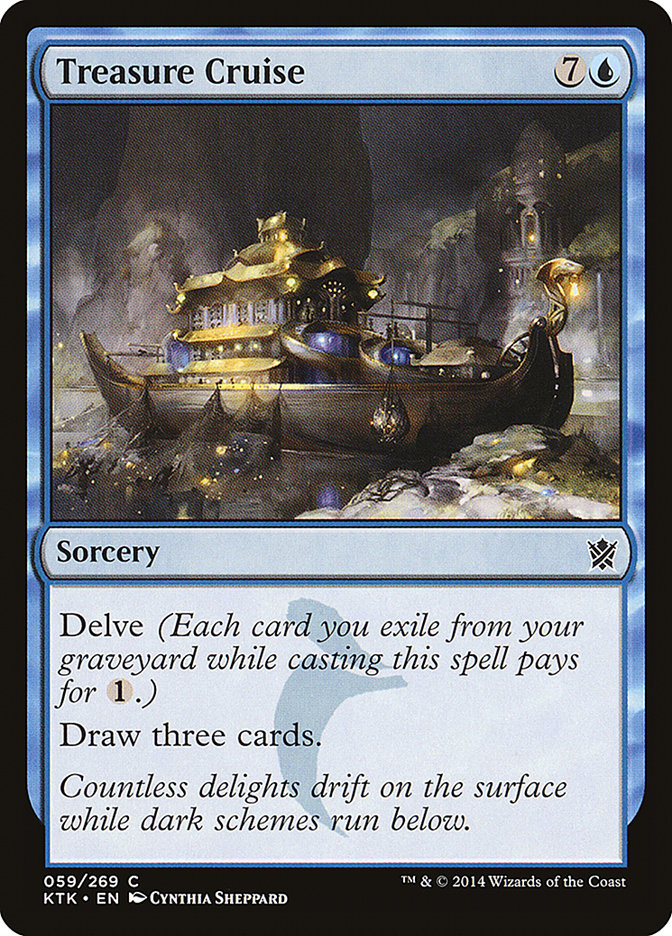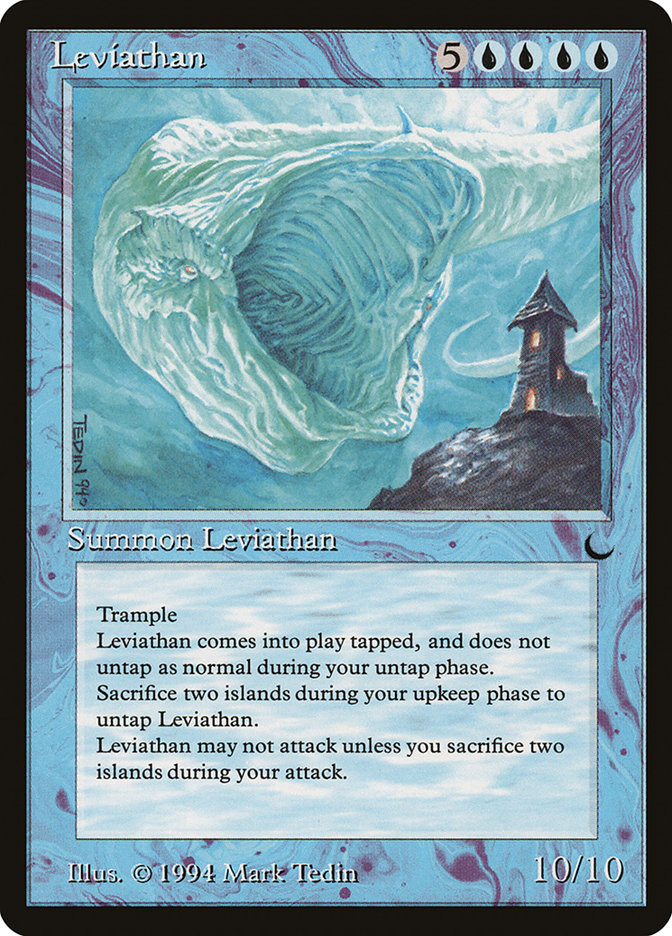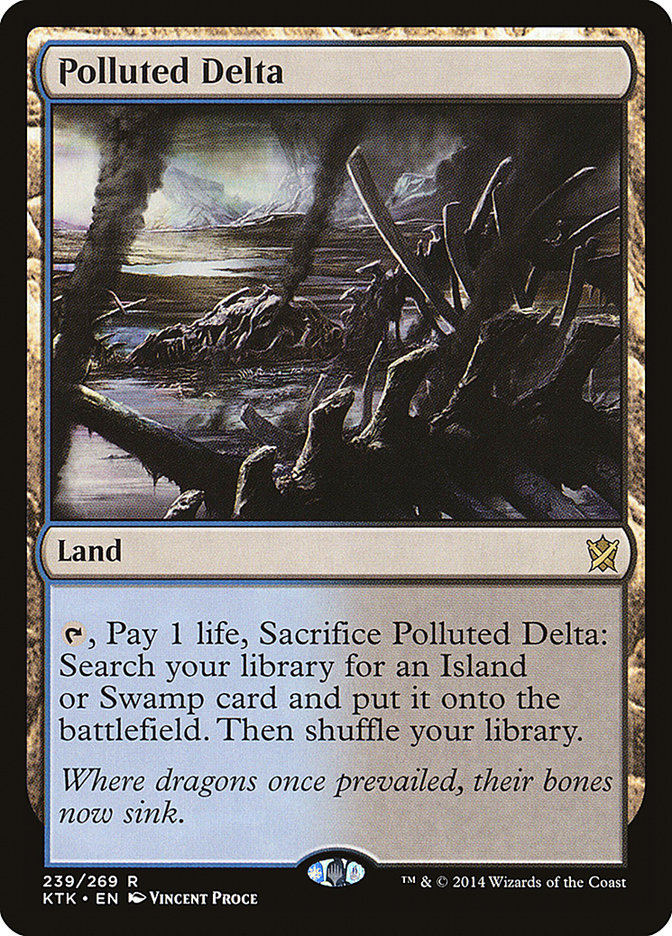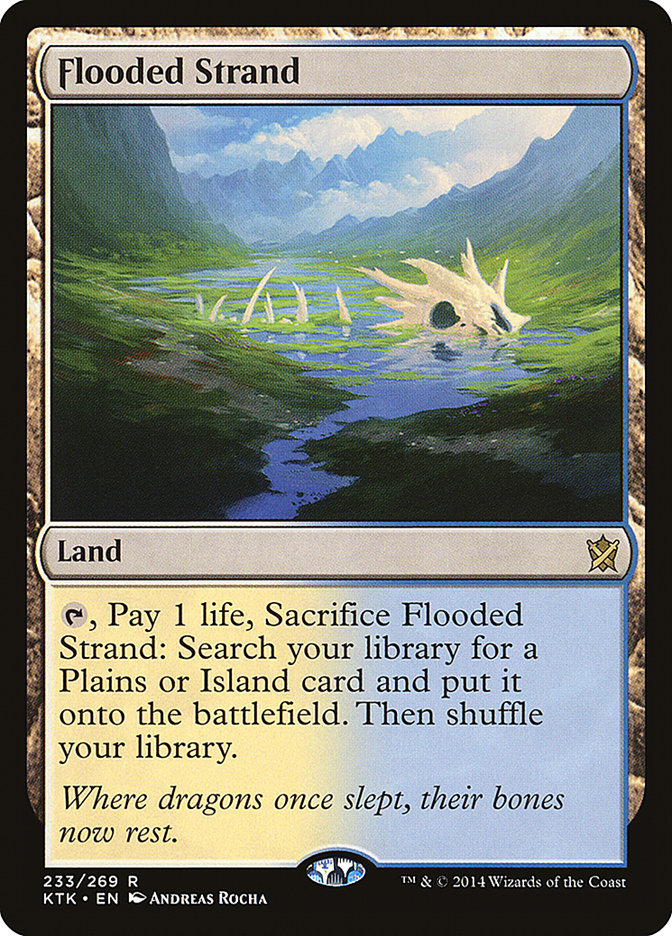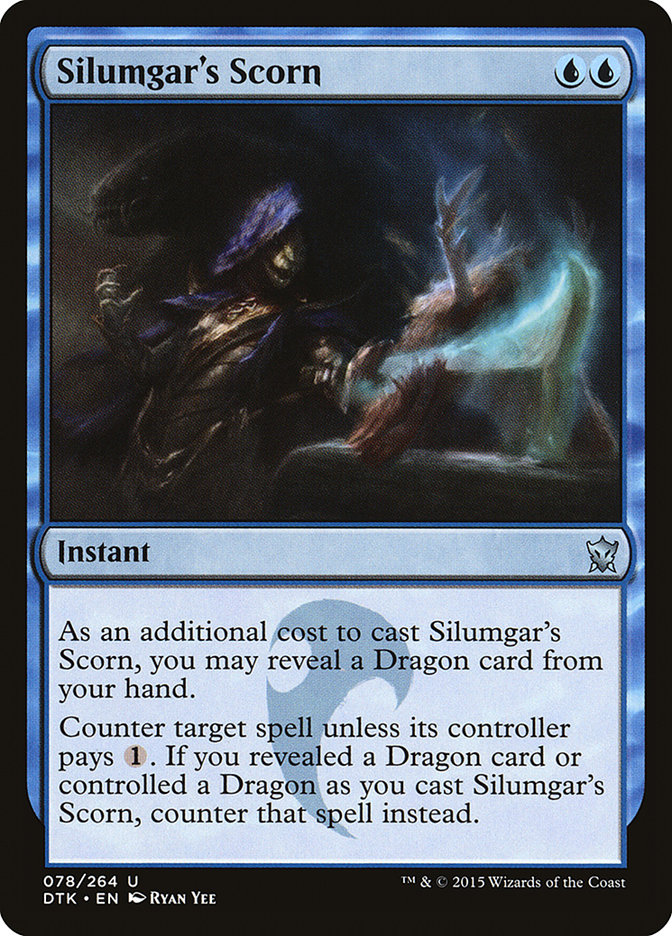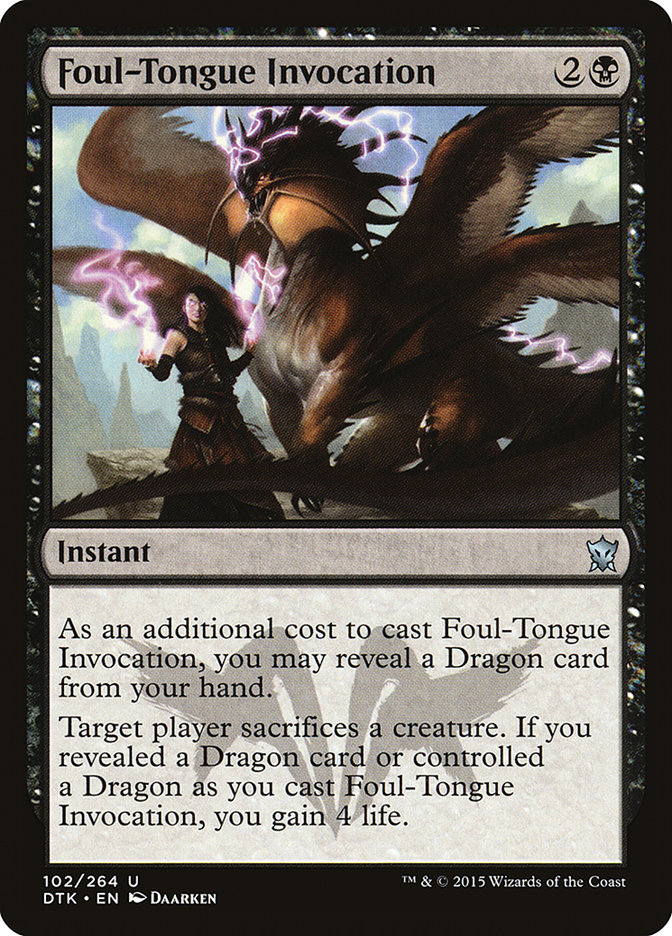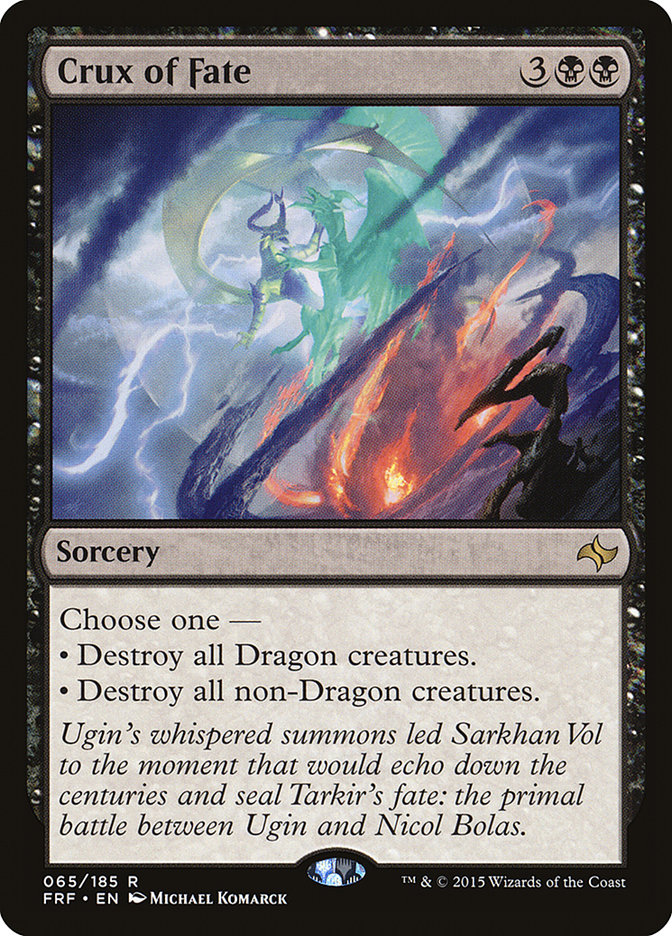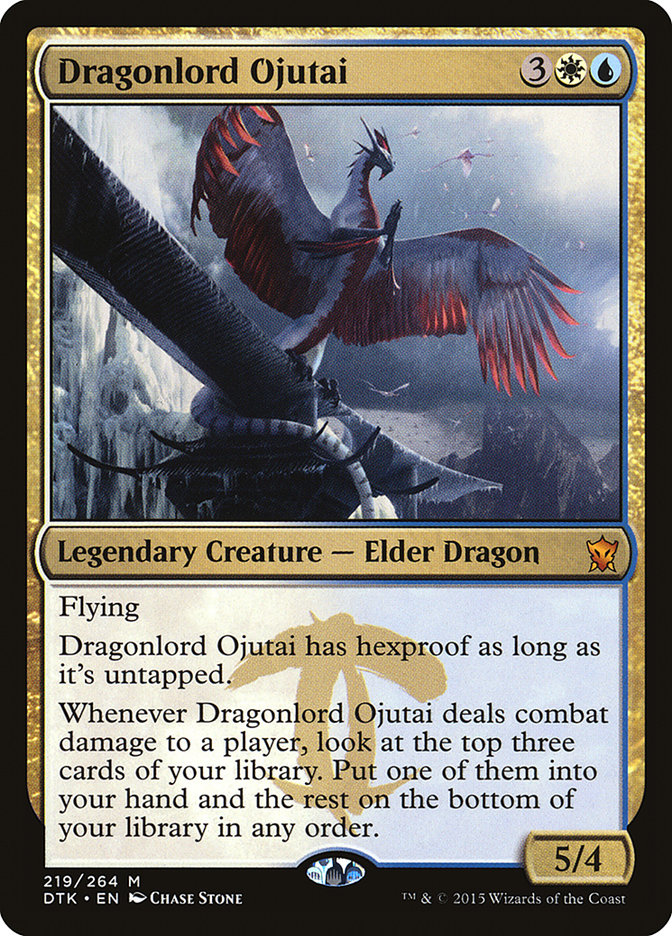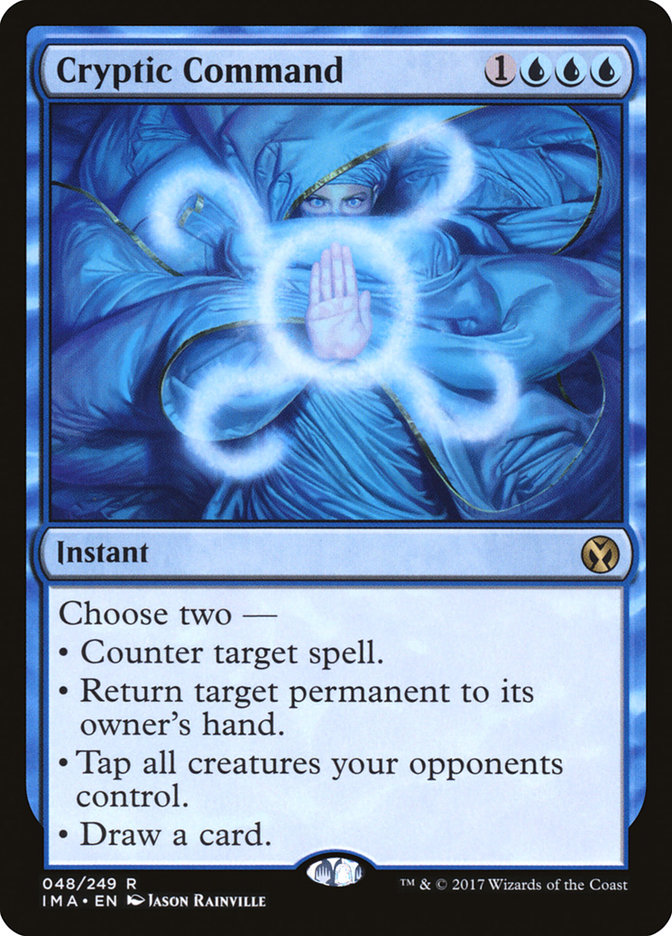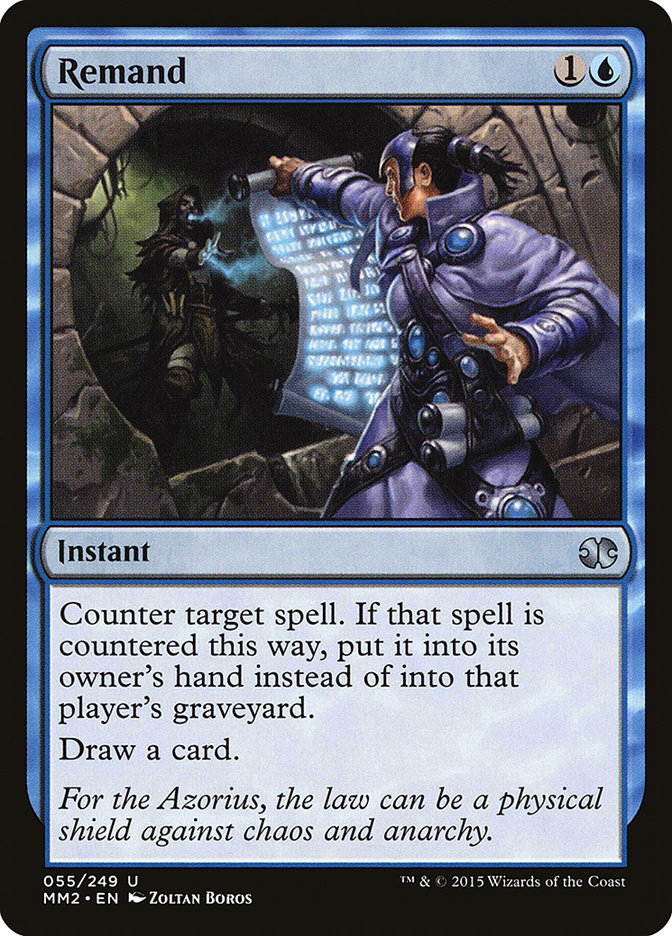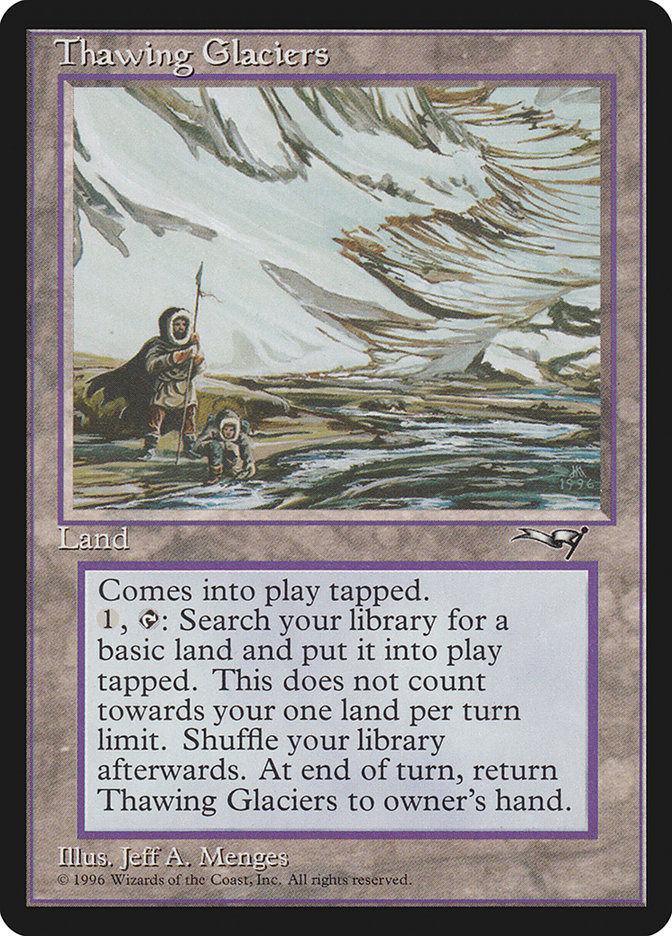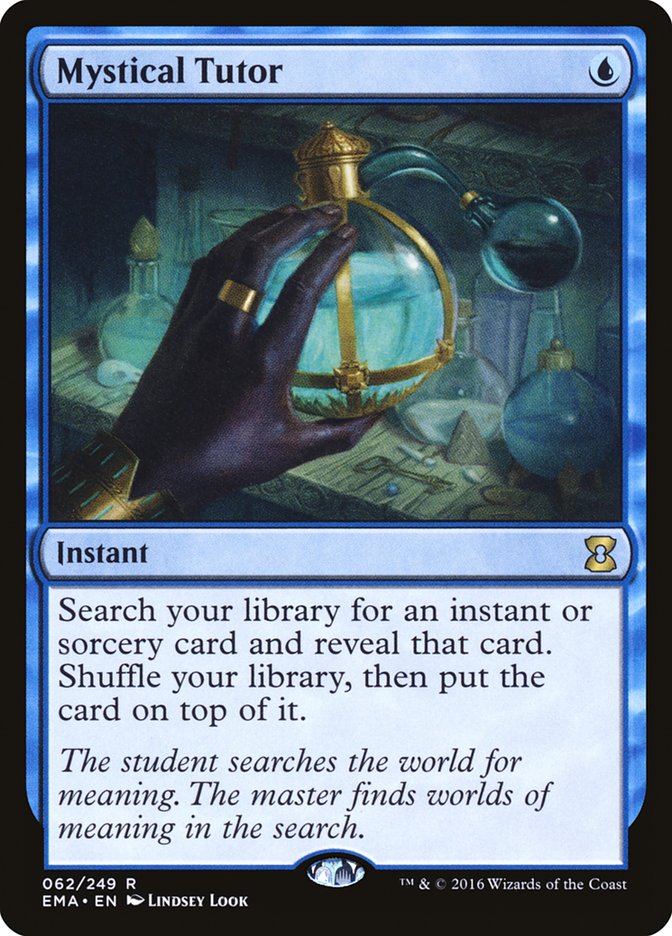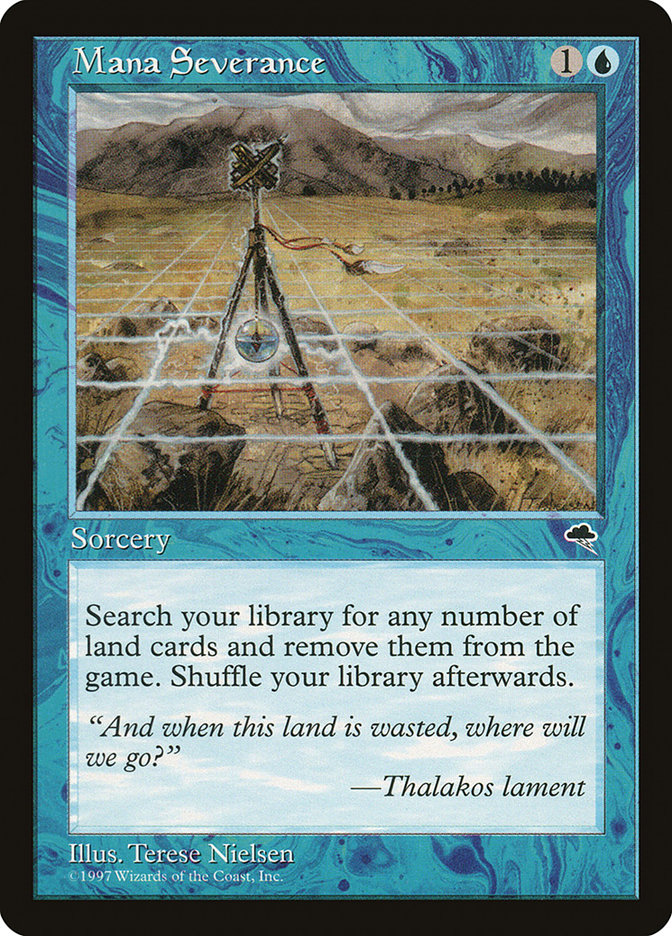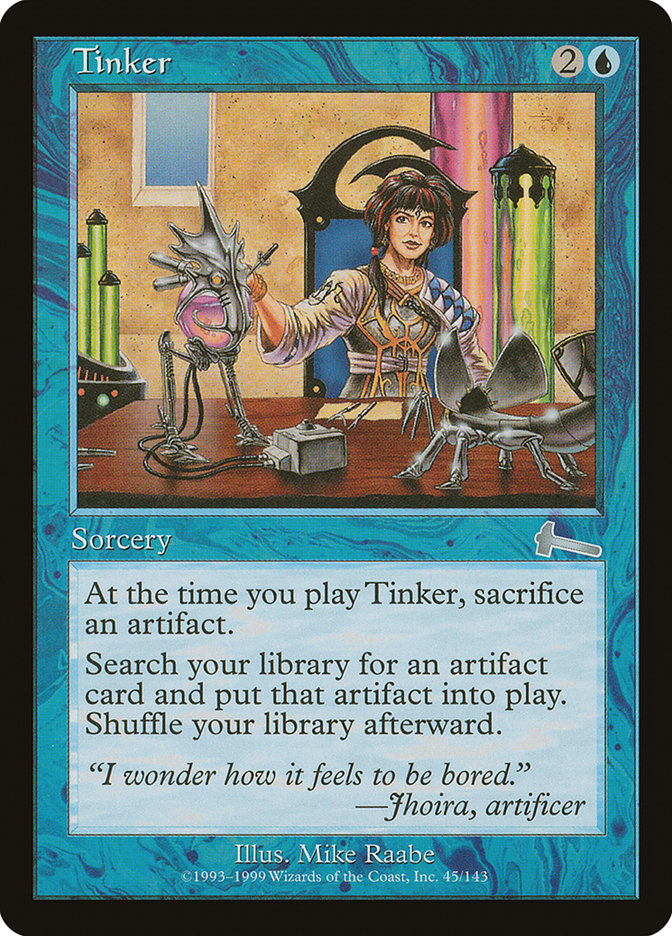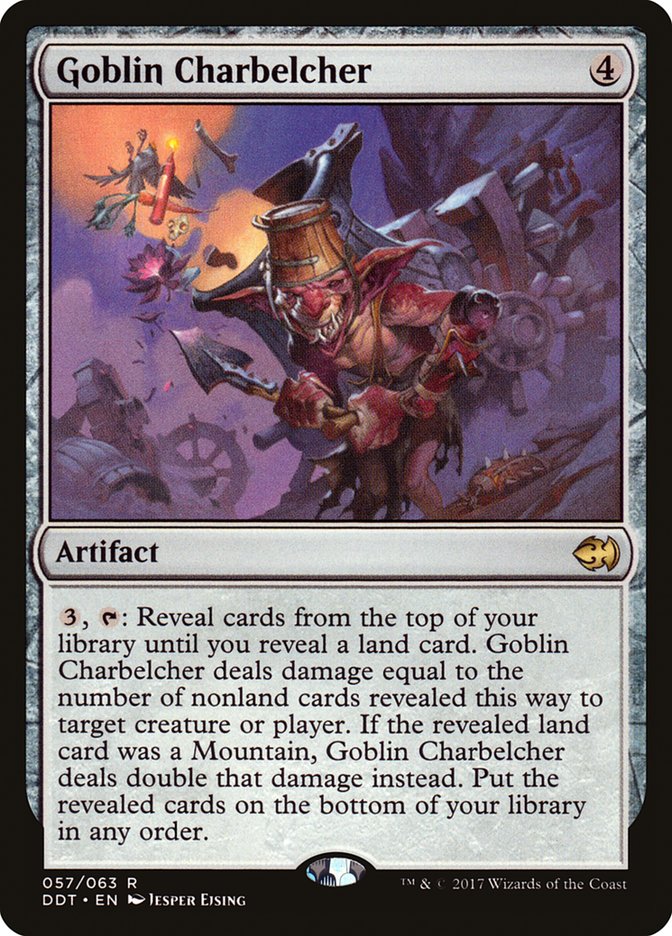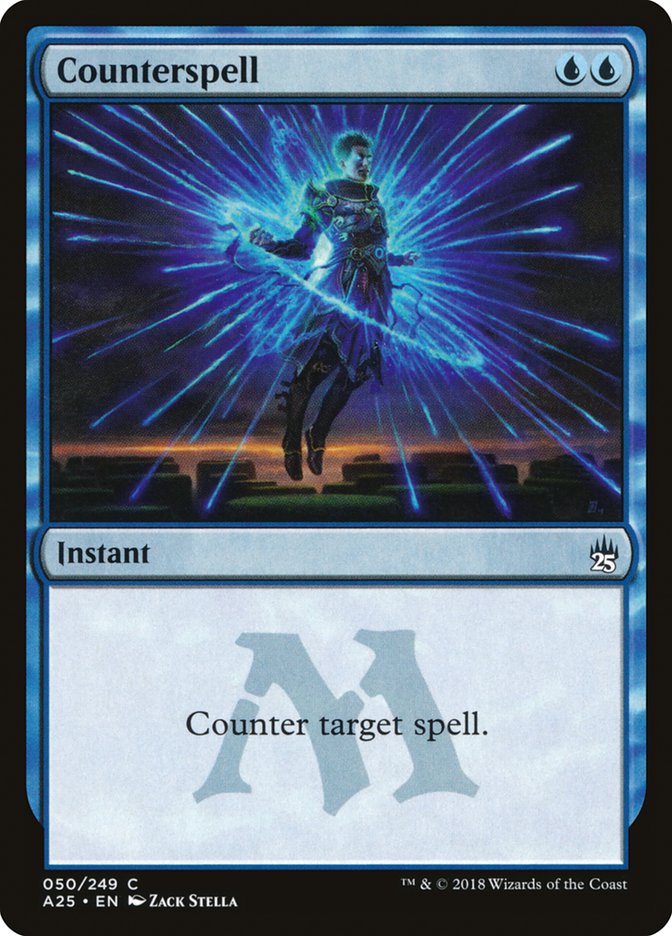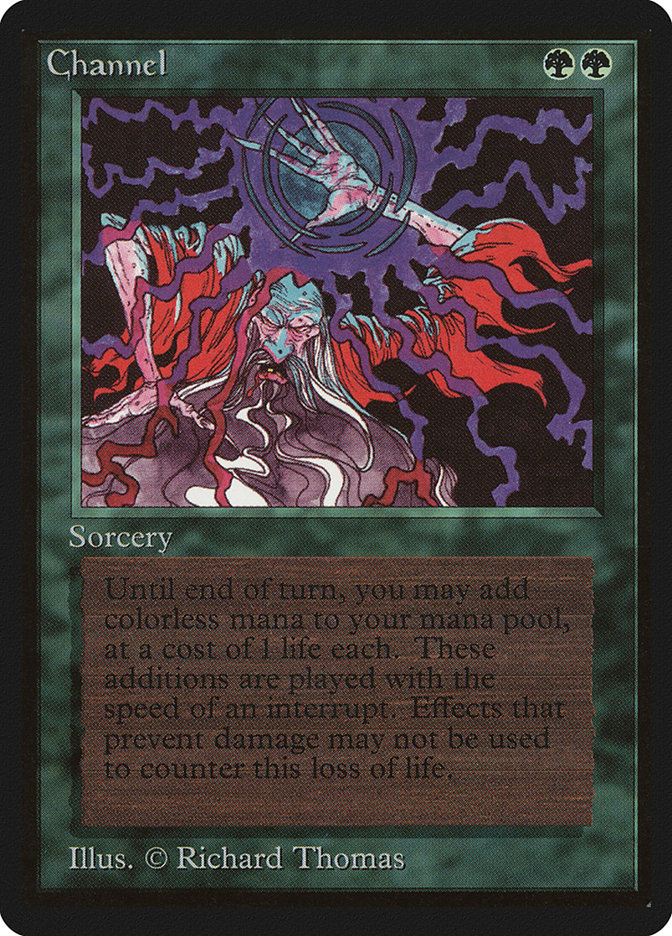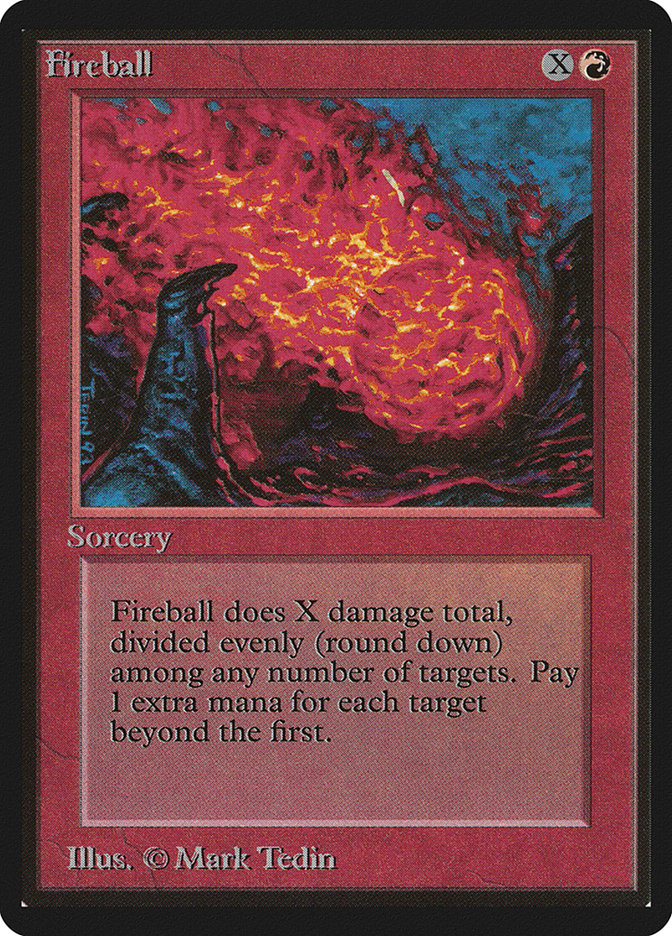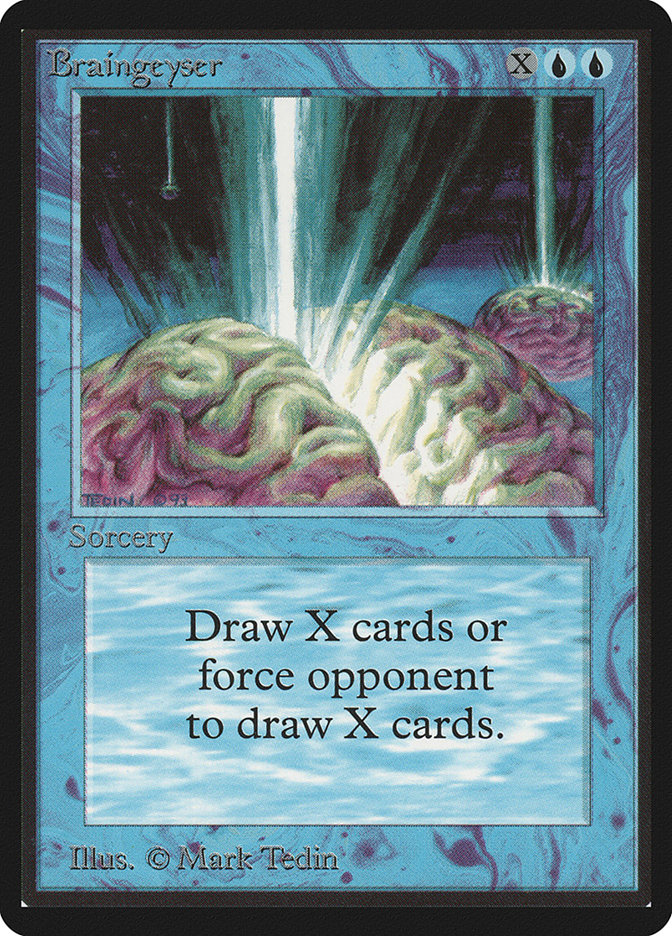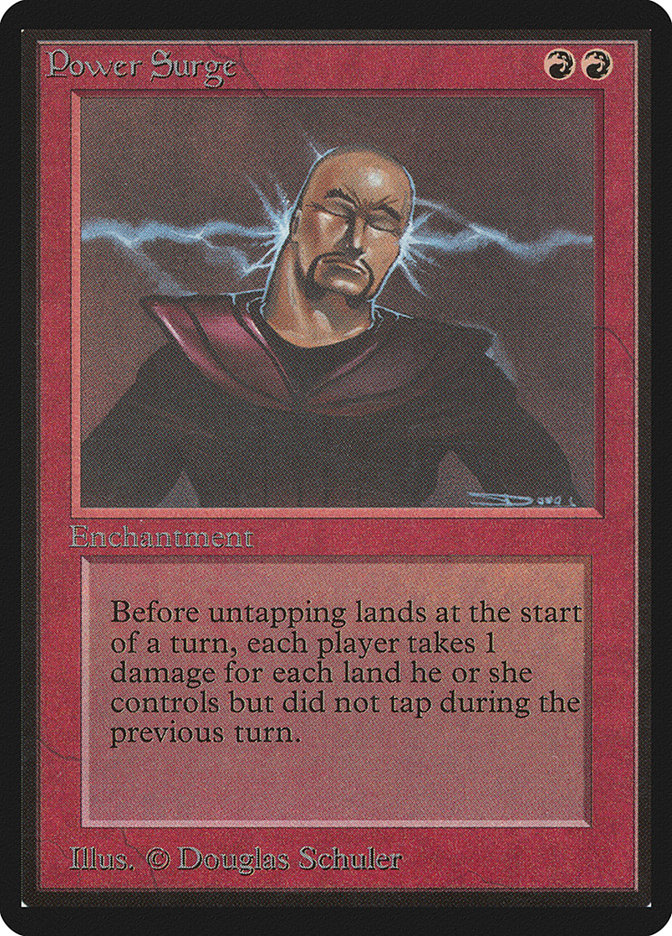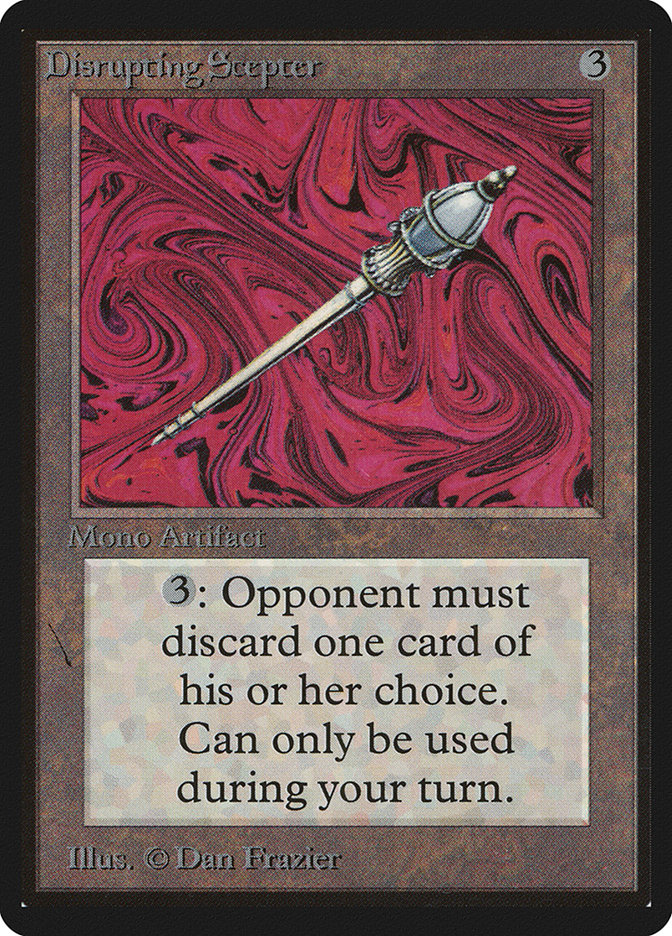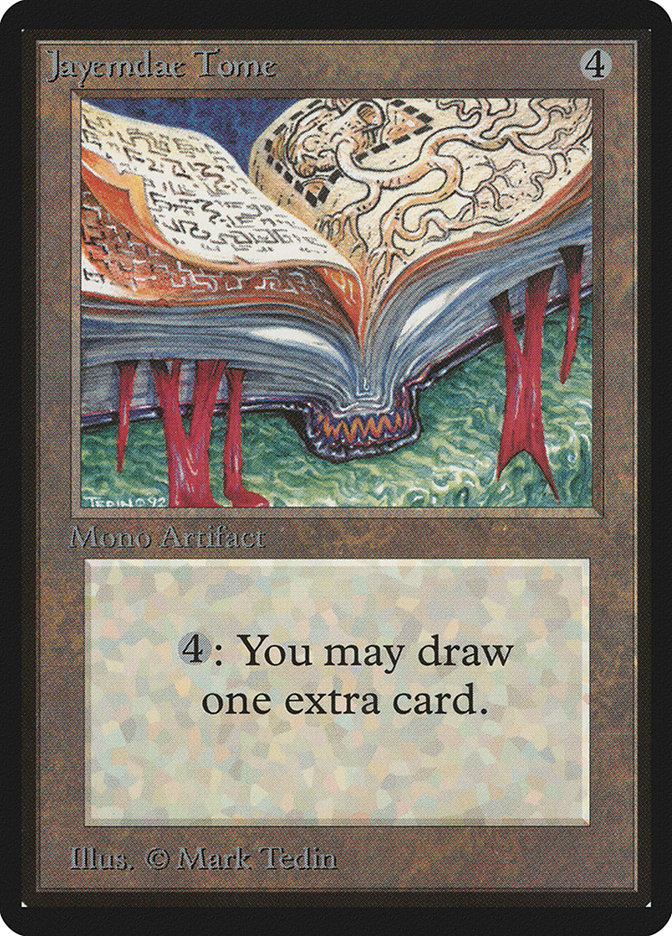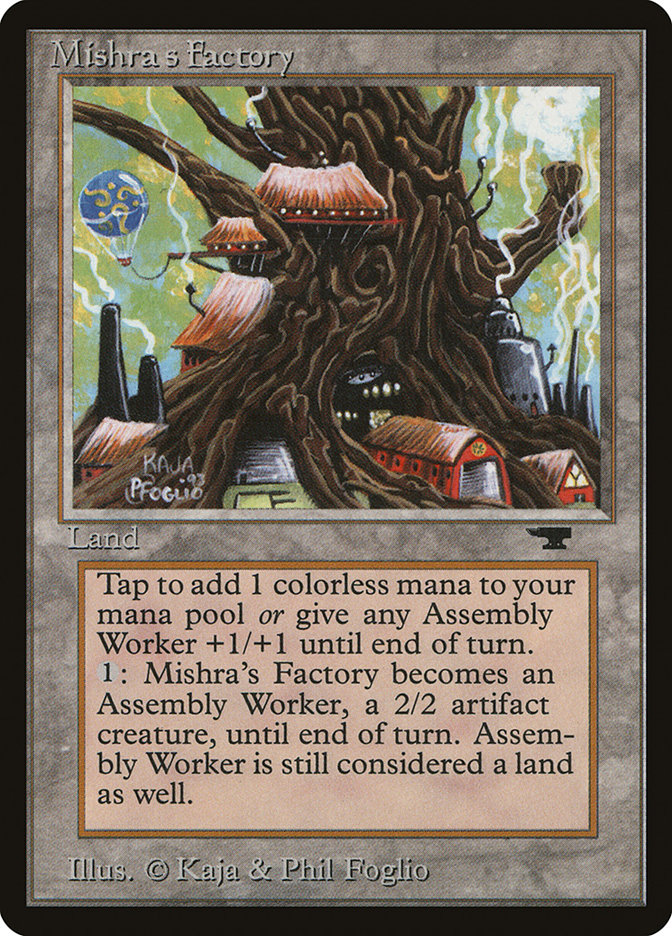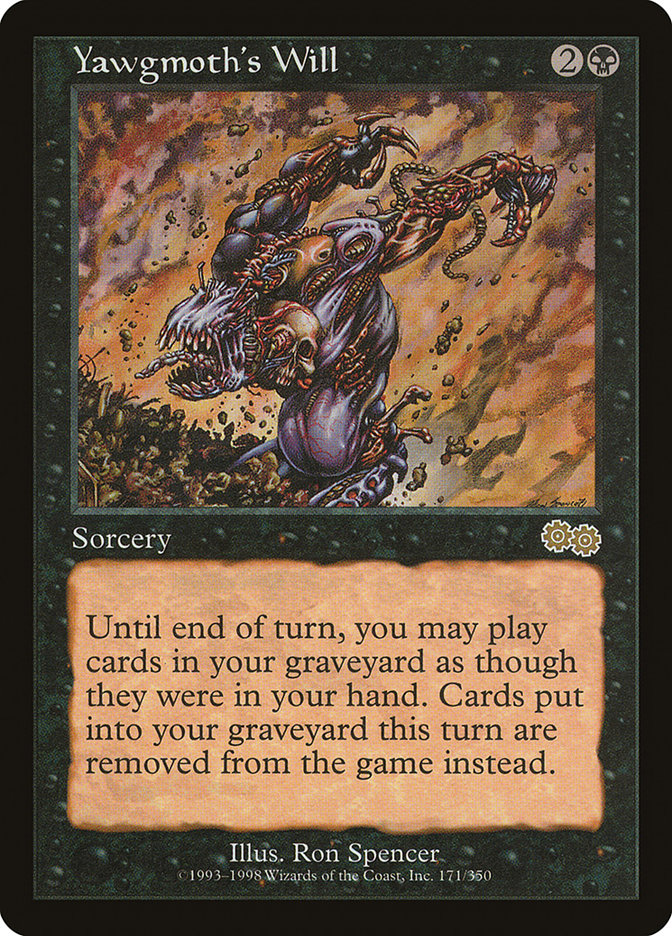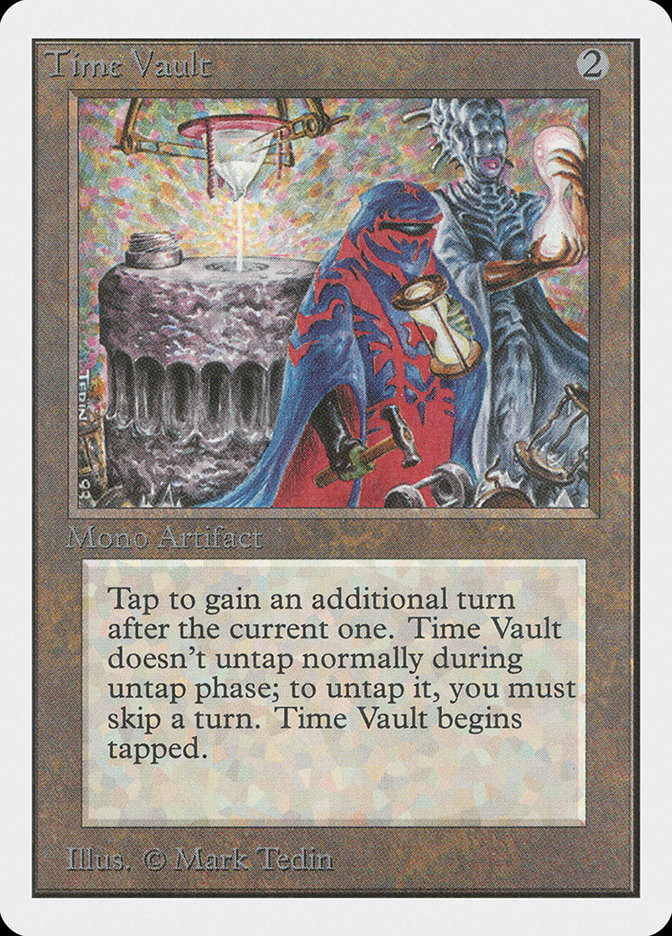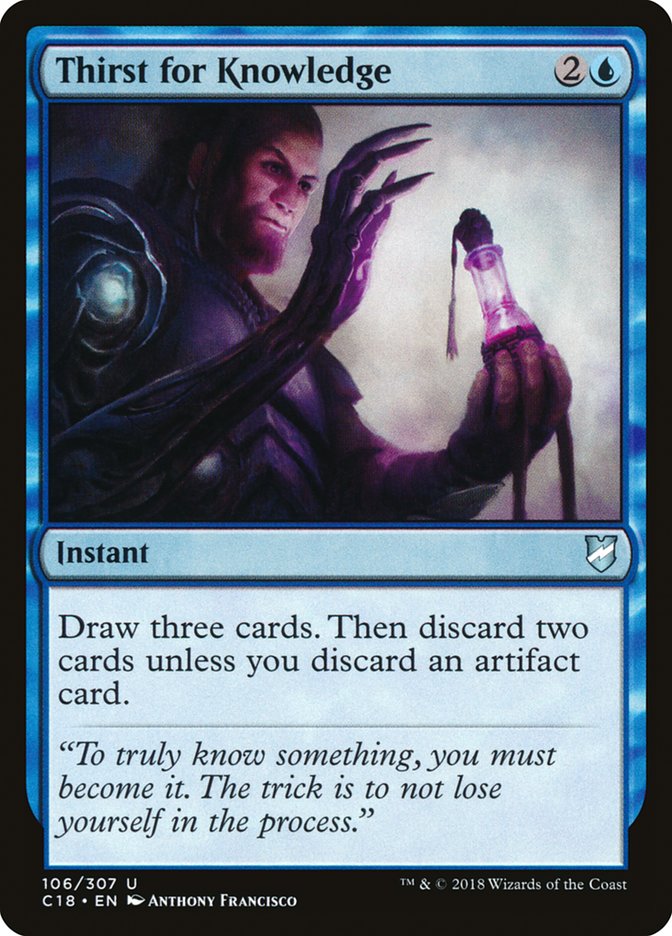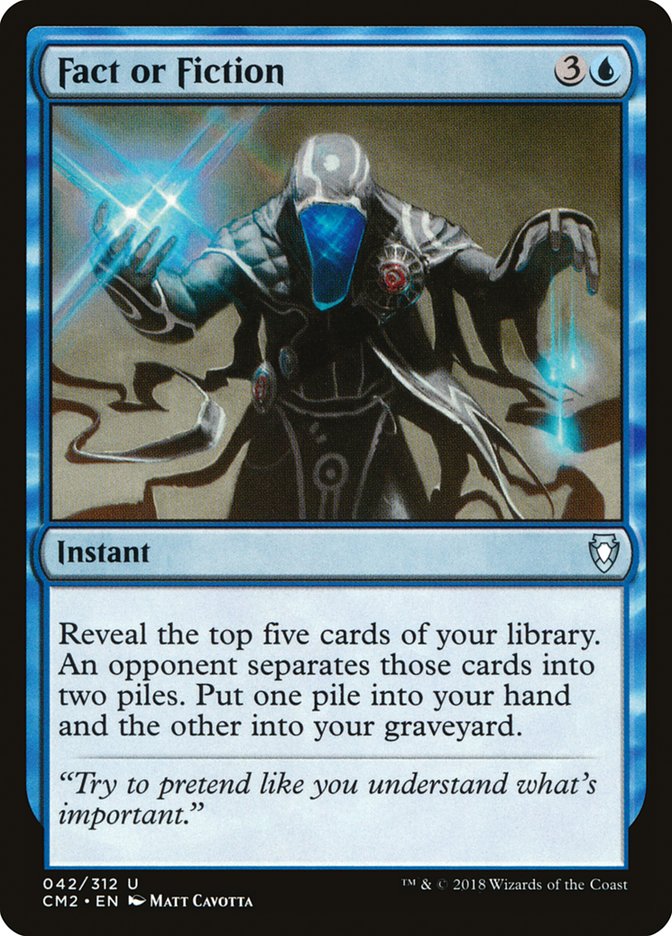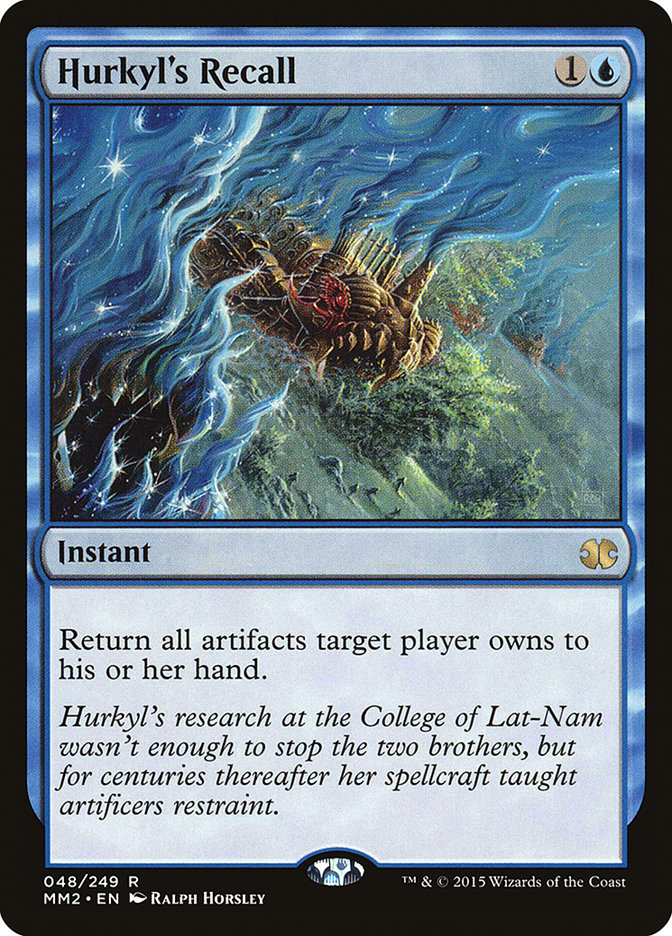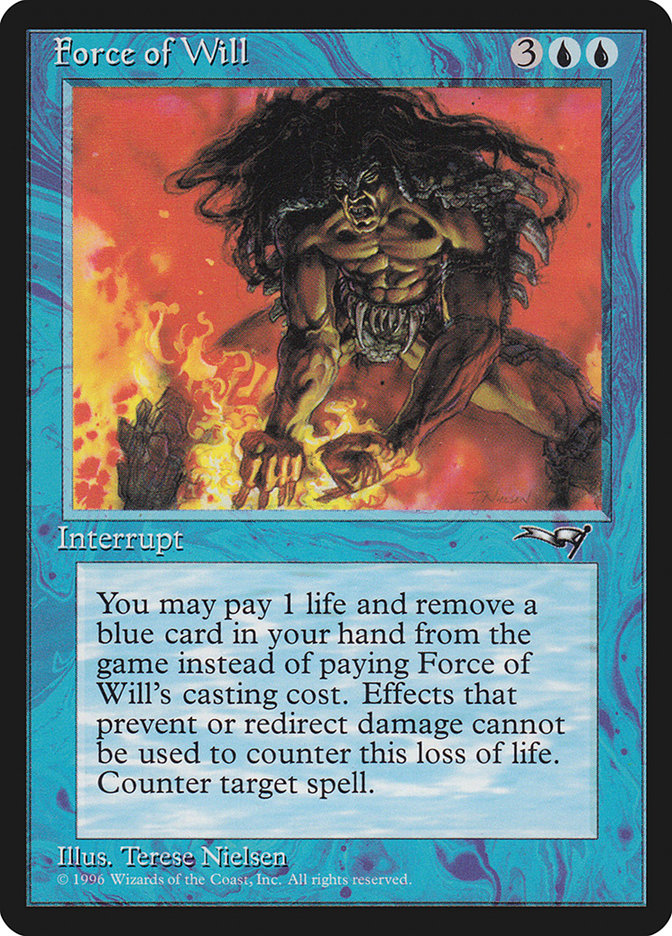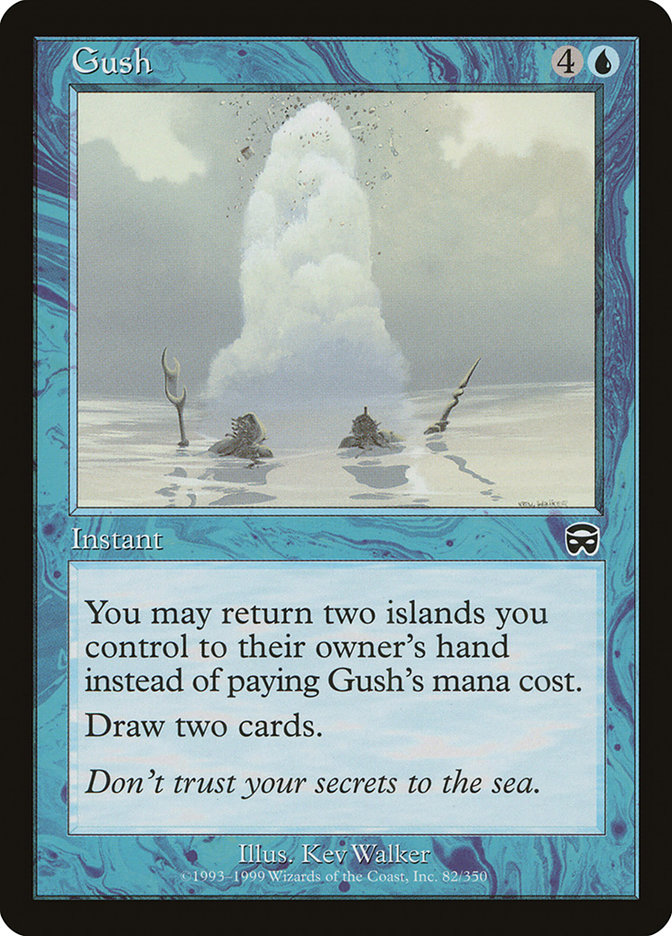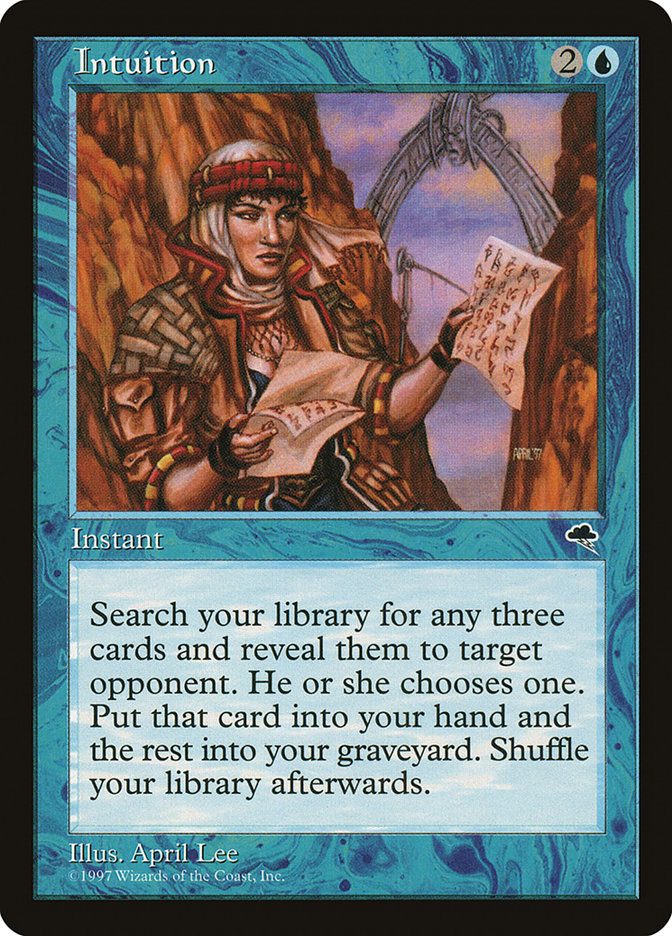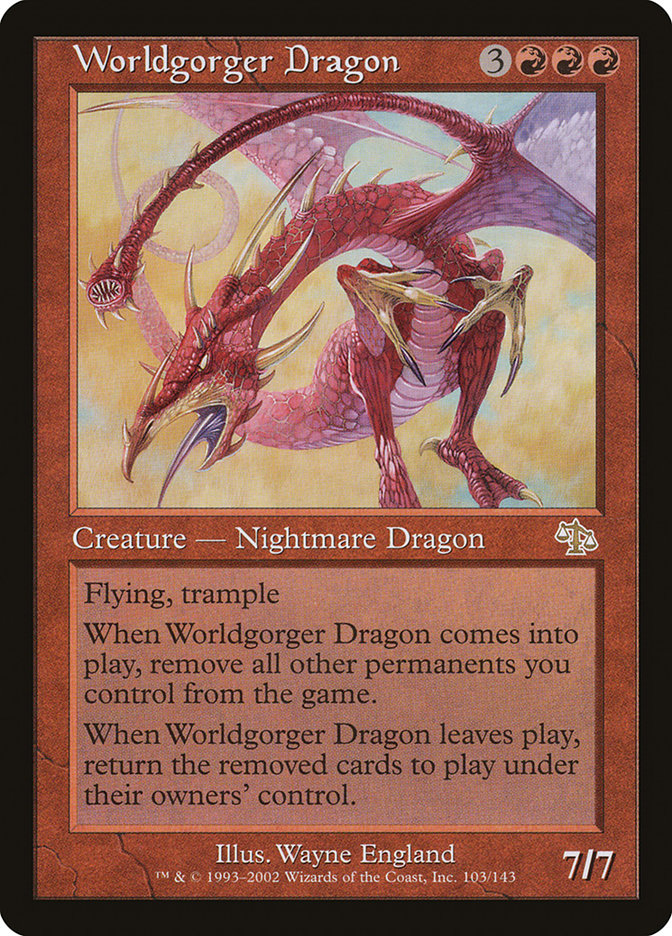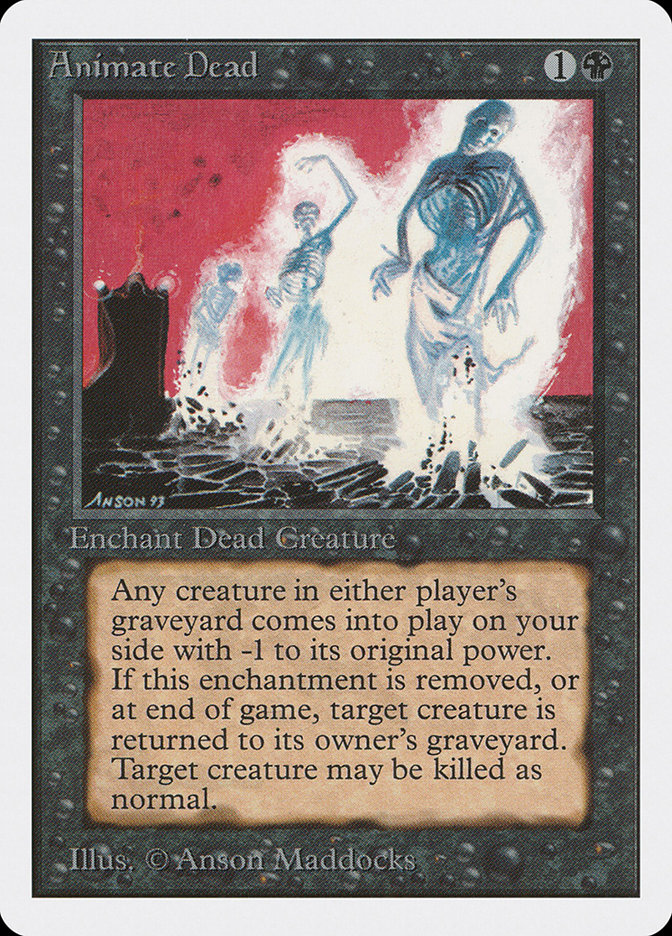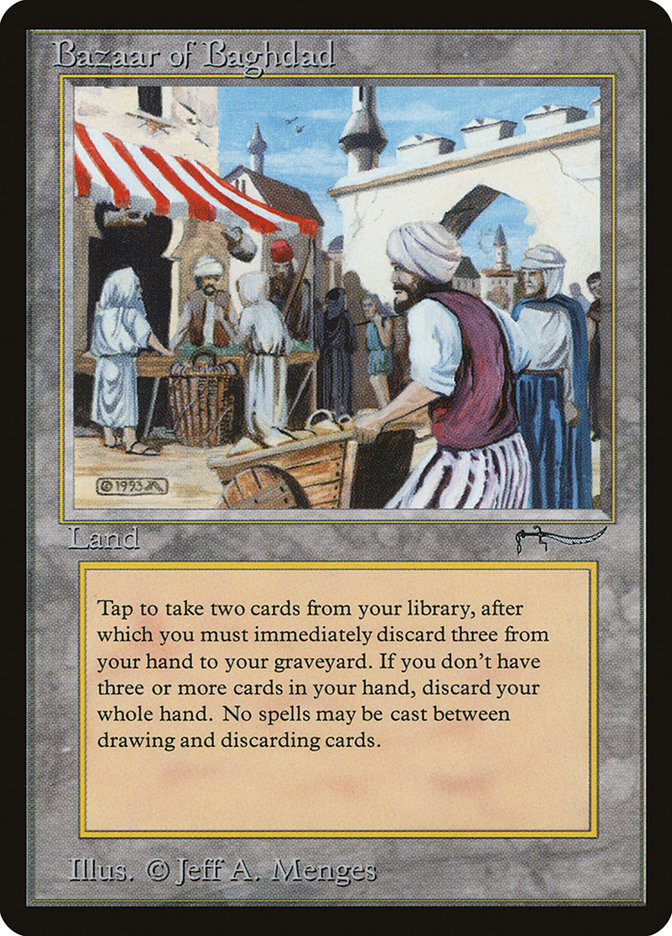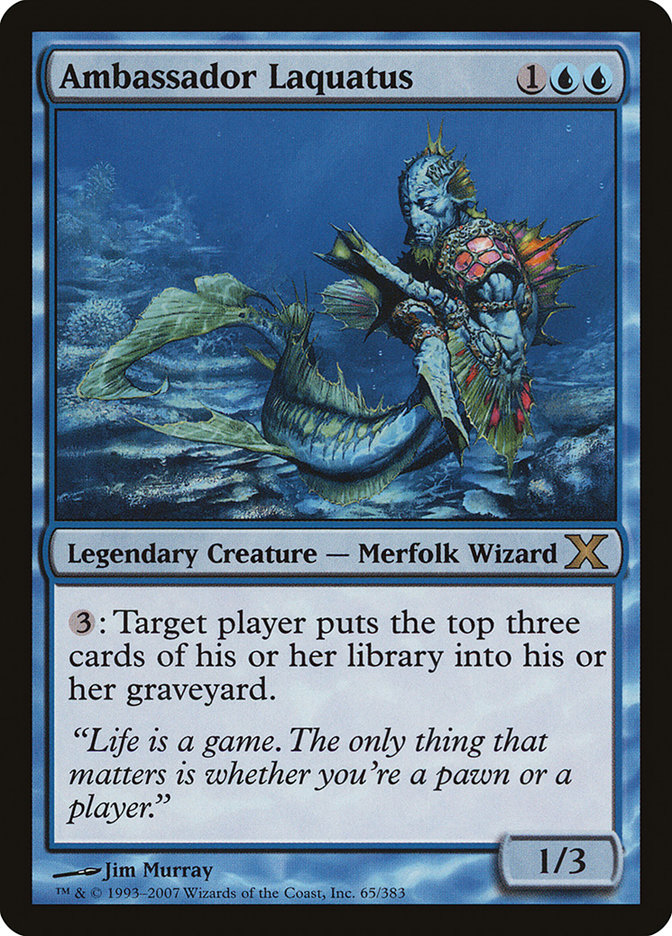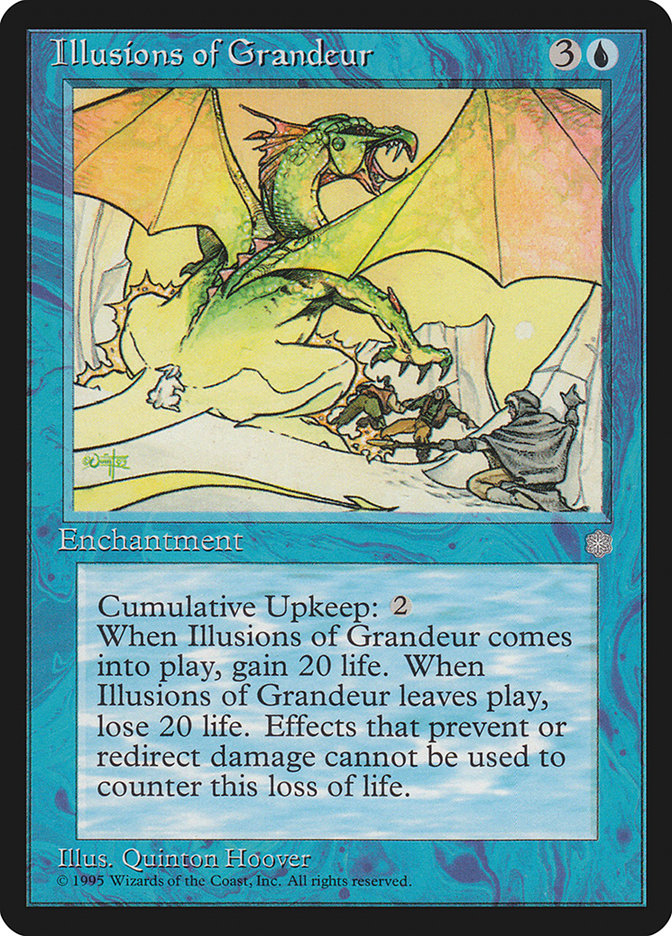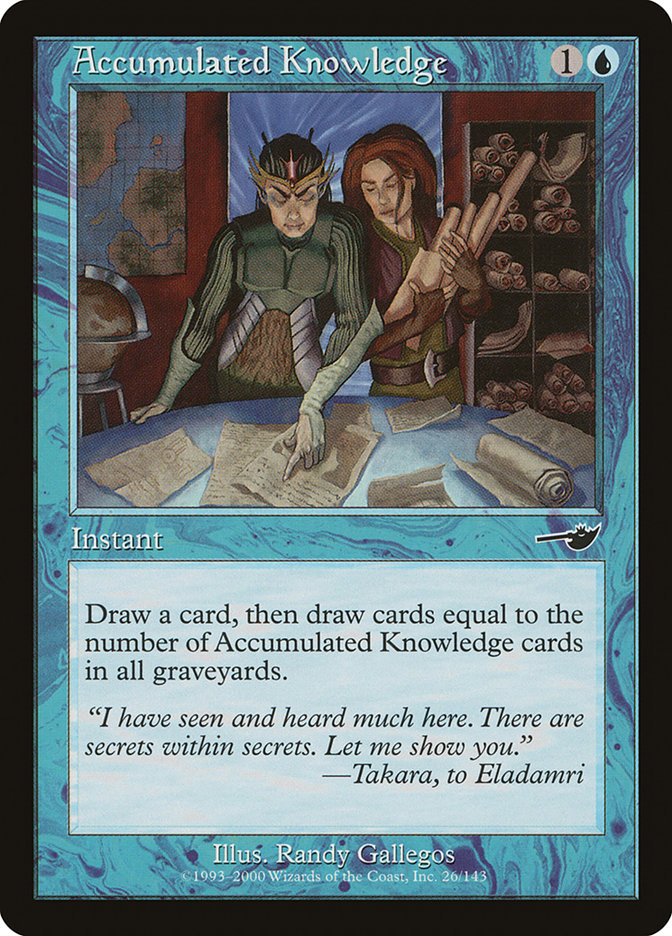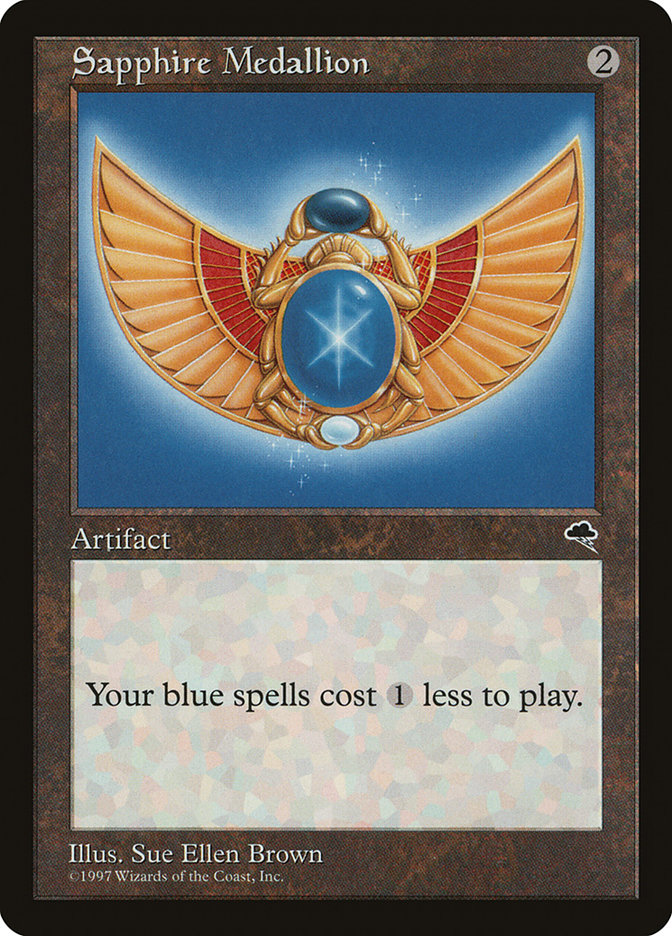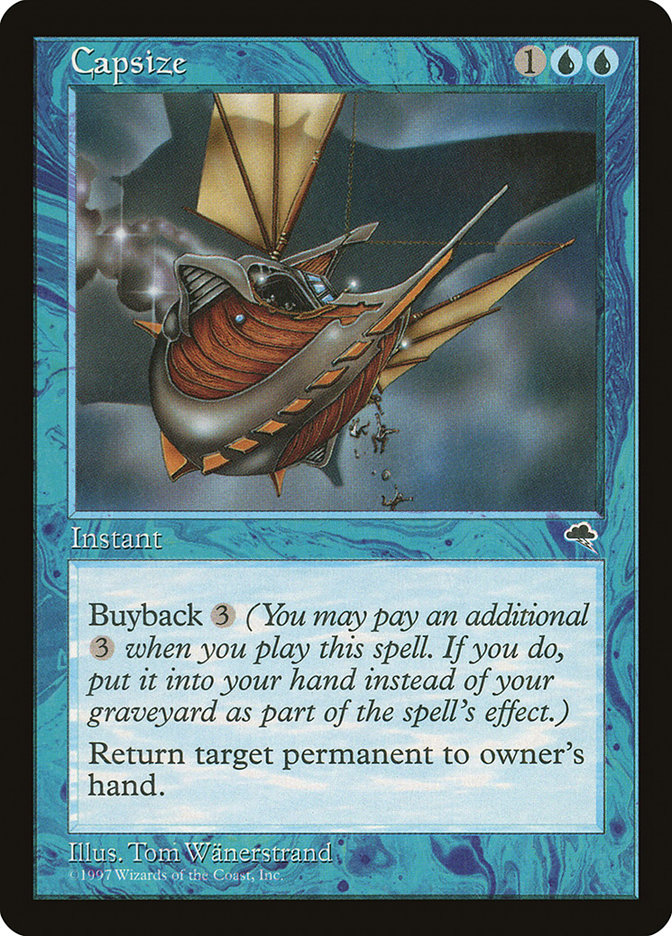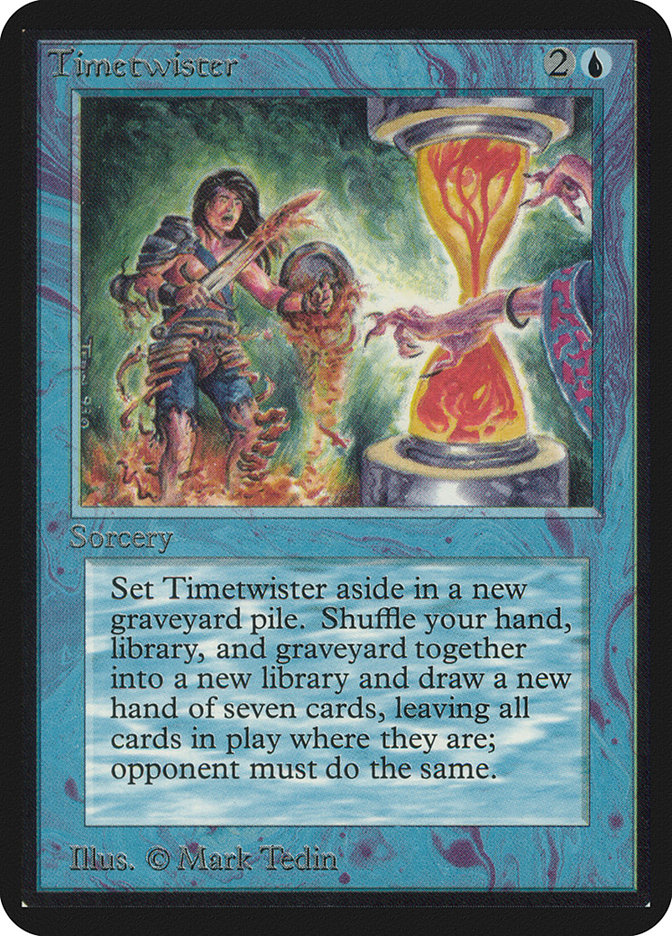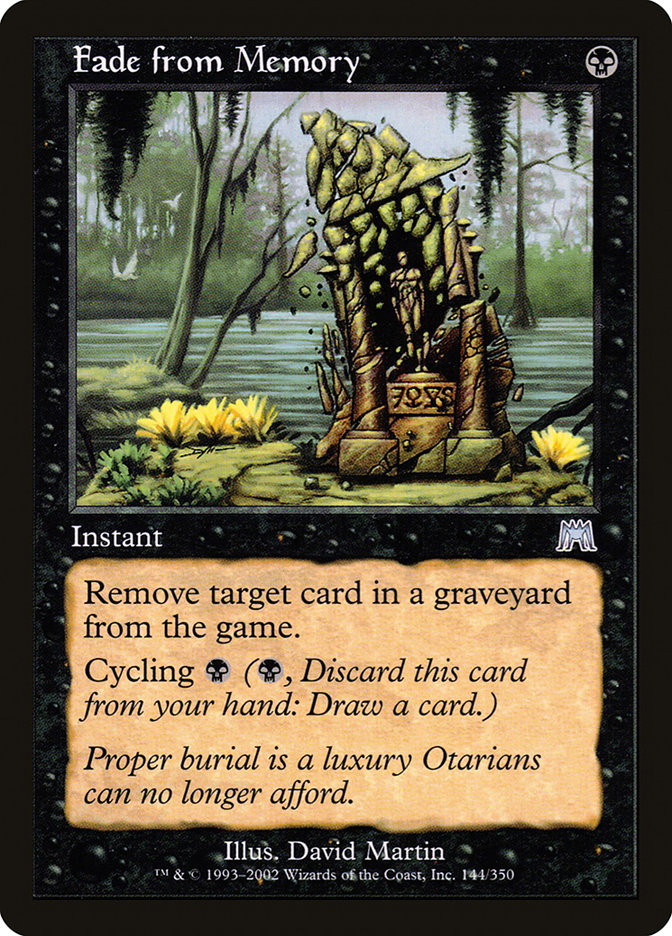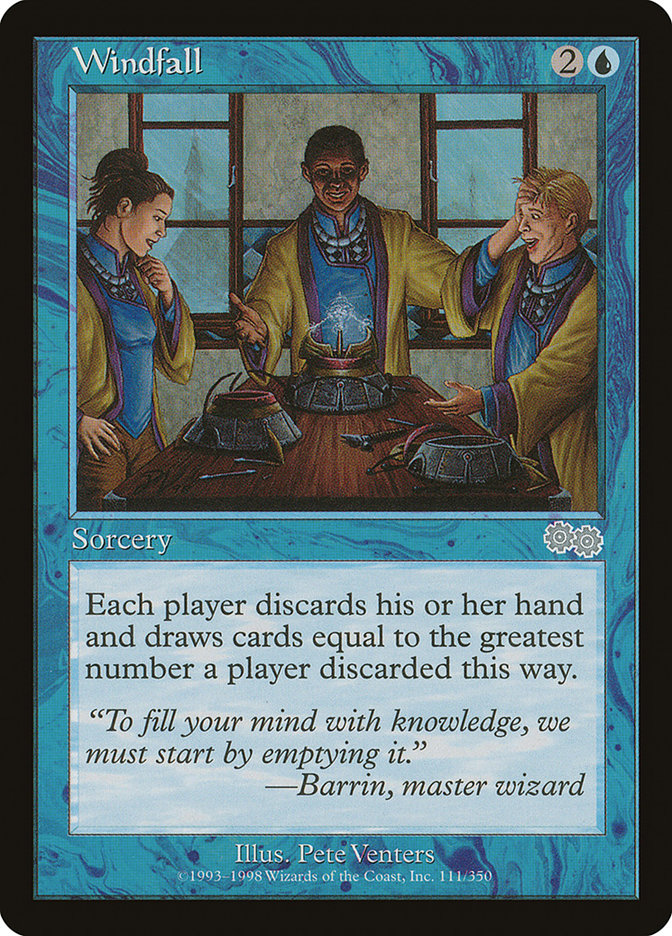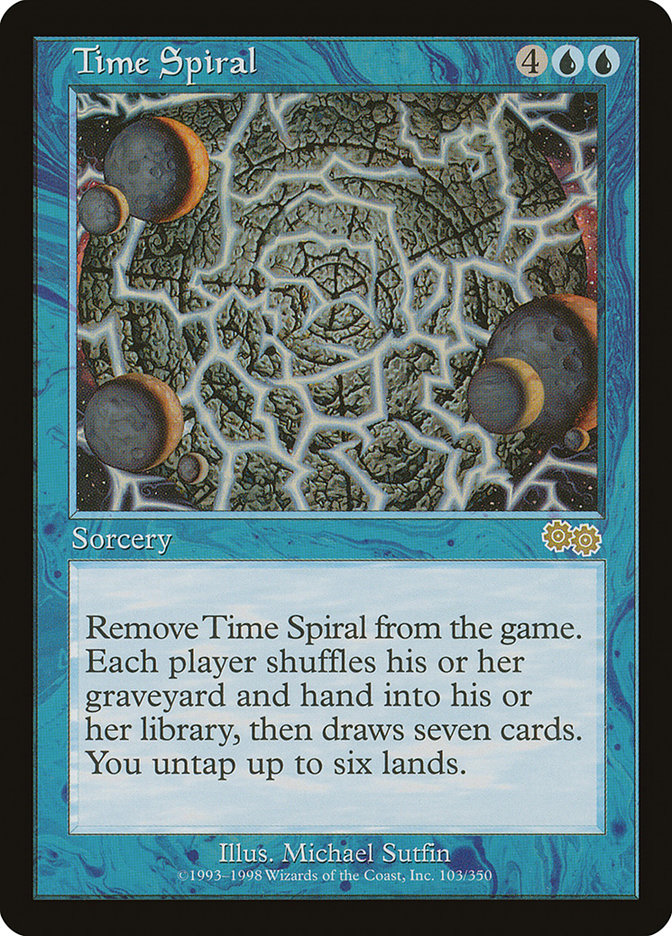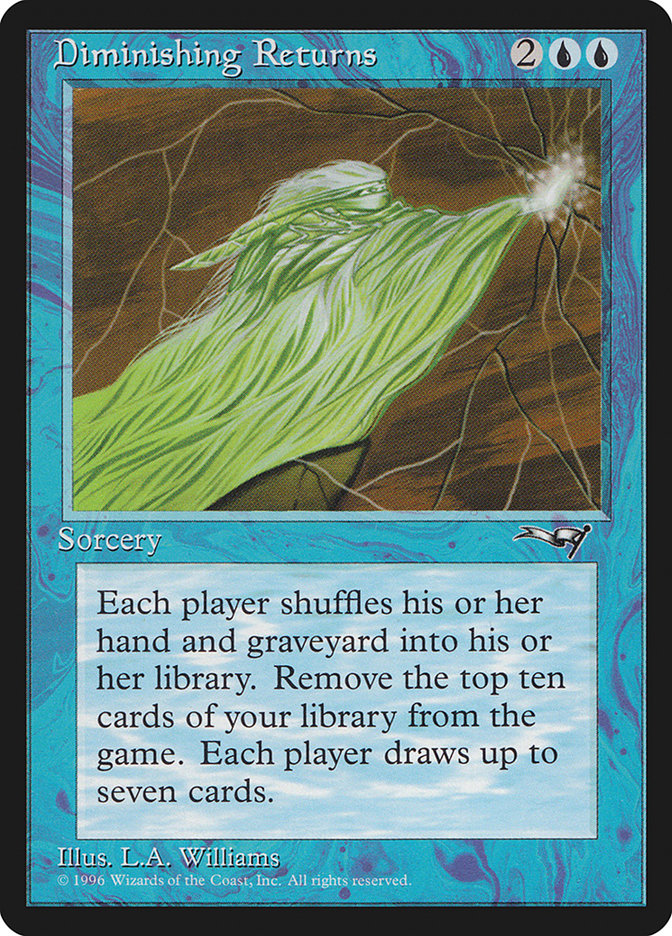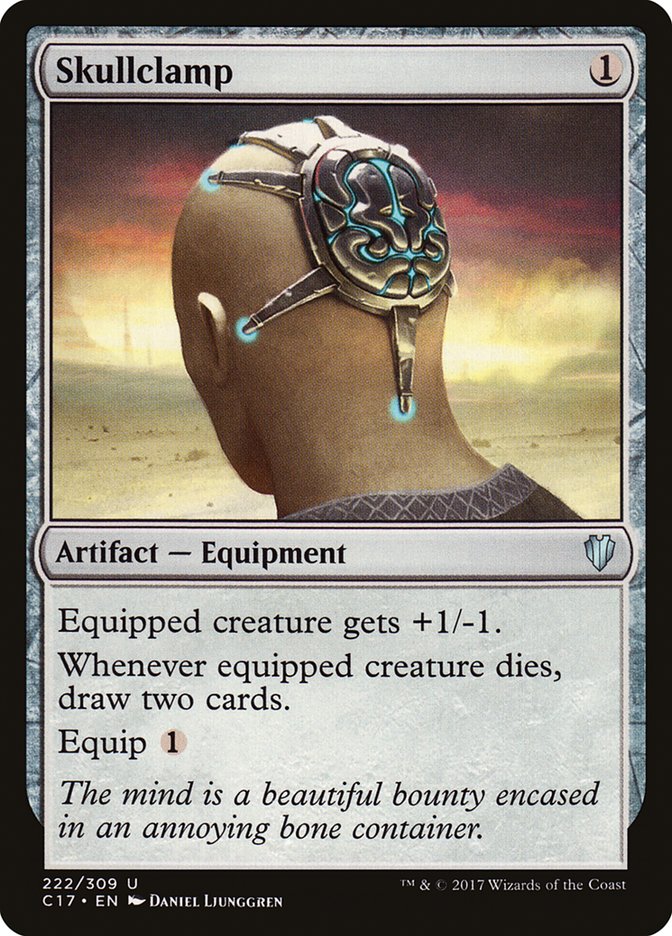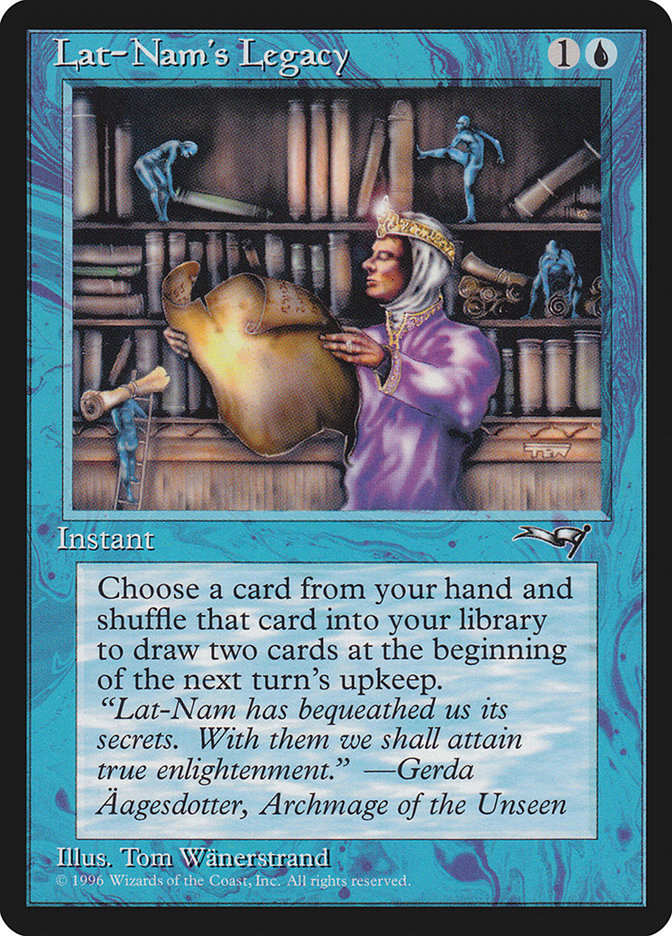When we last left off, we were discussing cards that would be in most colors’ Top 5 all-time…
Which, of course, means we weren’t quite to blue’s Top 10.
1994 was a rather silly year, but dear lord, did we dig it at the time.
#10: Dig Through Time
Dig Through Time is a lot like Demonic Tutor, except it’s blue, so you get two.
I can’t help but wonder what could have been if the delve cards were printed at a time where they would have to stand on their own for most of Standard without being propped up by fetchlands the whole time.
Nevertheless, Dig Through Time, like Treasure Cruise, was extremely powerful in Standard, very pushy but overall a really positive contribution to the format that helped make Khans of Tarkir one of the best-designed sets the game has ever seen.
While basically all blue decks were either Treasure Cruise decks or Dig Through Time decks, there was definitely a wide variety among those. Treasure Cruise was frequently a part of fast aggressive strategies that might just want to reload, but without powerful enough cards to be willing to pay a premium for the selection Dig Through Time offered.
Creatures (6)
Planeswalkers (1)
Lands (26)
Spells (27)

This U/B Control deck was built to capitalize on Silumgar’s Scorn, with a touch of Foul-Tongue Invocation and Crux of Fate.
Having powerful cards like Crux of Fate to find makes Dig Through Time a lot better. Even just being able to find a Dragon more reliably can make a big difference and Dig Through Time gives us a lot of looks. While most players preferred Dragonlord Ojutai as part of the squad, Shota went with Icefall Regent instead in order to stay just U/B.
You know, since it’s Shota, and he basically forces U/B in all Constructed formats, all of the time.
In Modern, Dig Through Time and Treasure Cruise split the format, more or less, along the lines of Treasure Cruise appearing in aggro and tempo decks while Dig Through Time was preferred by control and combo decks, such as the following deck looking to find Scapeshift and seven land.
Creatures (6)
Lands (25)
Spells (29)

If you think chaining Cryptic Commands is annoying, just wait and see how many Cryptics you can draw when you play a playset of Dig Through Times.
Notably, Dig Through Time also helped make sideboard cards extra-high-impact, if only because they showed up so much more often.
Honorable mention to Remand, which is both definitely way too good and definitely not close to cracking the Top 25.
#9: Brainstorm
Brainstorm is one of the most powerful cards to ever fly under the radar so effectively for so long. It’s understandable, given just how hard it can be to really understand opportunity cost and to fully appreciate the selection Brainstorm gives us access to, but the technology of cost-efficient cards that shuffle pushed it over the edge.
Alliances was a pretty revolutionary set, and Thawing Glaciers was an important part of that revolution. While there was no end of strategies finding ways to incorporate Thawing Glaciers into their manabases, most people did not make the leap to Brainstorm for quite a while.
Lands (22)
Spells (38)

Jon Finkel is not most people.
At the time, Jon was quietly regarded as the best player to have never Top 8’ed a Pro Tour by players in the know. Known for playing control and lock decks, a young Jon Finkel was one of the first players to realize the power of Brainstorm followed by shuffling (such as with Thawing Glaciers or putting cards on the bottom with Impulse).
By the way, geeze, that Impulse isn’t in the ZIP code of this list just feels so funny, when I think back to what it would have been like if you had told me that twenty years ago.
For context on just how under the radar Brainstorm was, here’s the eventual champion and shortlist Hall of Fame candidate, Justin Gary’s U/R list from that same event:
Creatures (12)
Lands (22)
Spells (26)
- 2 Nevinyrral's Disk
- 4 Counterspell
- 4 Dissipate
- 4 Force of Will
- 3 Earthquake
- 3 Disintegrate
- 2 Incinerate
- 2 Serrated Arrows
- 2 Binding Grasp
Sideboard

Super rad deck, to be sure, but definitely could have benefited from a playset of Brainstorms.
To say that Brainstorm has enjoyed Legacy and Vintage success would be an understatement. Whether a part of control, aggro, tempo, or combo decks, Brainstorm was an absolutely defining force in Vintage until its eventual restriction, and to this day, is clearly way, way over the line for Legacy, except that it just gets a pass, because we want it.
Lands (20)
Spells (40)
- 4 Brainstorm
- 4 Mystical Tutor
- 4 Grim Monolith
- 4 Mana Severance
- 4 Force Spike
- 1 Mindslaver
- 4 Goblin Charbelcher
- 1 Gilded Lotus
- 3 Talisman of Progress
- 2 Talisman of Dominance
- 4 Tinker
- 2 Voltaic Key
- 1 Rushing River
- 2 Chrome Mox
Sideboard

And it’s not just fetchlands that have been doing the shuffling.
When you just want to tutor up missing combo pieces anyway, getting free ways to reset the top of your deck thrown in is like frosting on top of the cake.
#8: Mana Drain
Over Brainstorm!?!
The kids these days just don’t give Mana Drain the credit it deserves.
You would think a card that tacks a free Dark Ritual onto one of the best cards of all-time would be obviously absurd to people. I mean, just try to walk through what turns of Standard would be like if Mana Drain was legal? Brainstorm would be too much, but even if fetchlands were legal, I just do not think it would not have as destructive of an impact as Mana Drain would have.
When I was your age, Mana Drain was widely regarded as one of the most broken cards in the game. Once someone played their second blue land, it completely changed the way you had to play against them.
The last thing you want to try to do on Turn 3 is tap out for a Hypnotic Specter or whatever. If they Mana Drain it, untap, and put a hole in your head, you’re toast. That Hypnotic Specter may very well be the last thing you try to do, after all.
I remember the feeling in my stomach the first time I lost a Taiga playing for ante against one of the older kids. I had hit him with a Lightning Bolt on my second turn, then untapped and Channel / Fireballed him out…
…and it was in that next moment that I learned what Mana Drain was.
I already knew what Braingeyser was, but I had never seen a Braingeyser for eighteen before.
In those days, Mana Drain wasn’t “strictly” better than Counterspell, thanks to mana burn, and it really did come up sometimes. Still, that kind of a burst of mana was just game-deciding (and paralyzing, once enough people figured out that you couldn’t walk face first into it or you would lose).
Obviously, X-spells were great mana sinks, but artifacts with healthy activation costs were also big-time favorites, and Mishra’s Factory was a potent “buy-out” for those spots where you needed to Mana Drain but had nothing to use it on, plus nothing on top of your deck.
Even when Vintage games moved into the Yawgmoth’s Will era, Mana Drain continued to play a key role, being one of the pillars the format was built on.
While that balance has shifted over the years (along with plenty of other archetype-defining cards that have come and gone), Mana Drain continues to find ways to make “control” viable, despite how intense of competition it faces.
Creatures (6)
Planeswalkers (1)
Lands (16)
Spells (37)
- 2 Sensei's Divining Top
- 1 Brainstorm
- 4 Mana Drain
- 1 Vampiric Tutor
- 1 Mystical Tutor
- 1 Yawgmoth's Will
- 4 Force of Will
- 1 Sol Ring
- 1 Demonic Tutor
- 1 Hurkyl's Recall
- 1 Time Walk
- 1 Ancestral Recall
- 1 Mana Crypt
- 1 Time Vault
- 1
- 1 Merchant Scroll
- 1 Rack and Ruin
- 1 Thirst for Knowledge
- 1 Chain of Vapor
- 1 Misdirection
- 1 Tinker
- 1 Voltaic Key
- 1 Black Lotus
- 1 Fact or Fiction
- 1 Mox Emerald
- 1 Mox Jet
- 1 Mox Pearl
- 1 Mox Ruby
- 1 Mox Sapphire
- 1 Darkblast

Before Jace, the Mind Sculptor and Dack Fayden had Vintage wrapped around their fingers, Tezzeret the Seeker was the Vintage planeswalker of choice. If you played it after Time Vault, you could just take infinite turns.
If you cast it without a Time Vault, you could go find it and threaten to take infinite turns, next turn.
It’s amusing just how many blue cards have been restricted at one point or another. Maybe that’s just the way it is with blue cards, but I think Mana Drain would be the most powerful card never restricted if not for this little number right here…
#7: Force of Will
Force of Will is the pinnacle of just how fast ultra-powerful interaction can be. I mean, easily and reliably hardcountering before you’ve ever taken a turn? It’s hard to be much faster than that.
Force of Will’s ridiculous power level is given a pass in Legacy and Vintage in order to help suppress the amount of first-turn kills. It has been especially potent in “fair” decks that place a premium on tempo.
Creatures (5)
Lands (14)
Spells (41)
- 4 Brainstorm
- 1 Fastbond
- 2 Mana Drain
- 1 Vampiric Tutor
- 1 Mystical Tutor
- 1 Yawgmoth's Will
- 4 Duress
- 4 Force of Will
- 1 Demonic Tutor
- 1 Time Walk
- 1 Ancestral Recall
- 1 Red Elemental Blast
- 4 Gush
- 1 Cunning Wish
- 4 Merchant Scroll
- 2 Misdirection
- 1 Black Lotus
- 3 Opt
- 1 Mox Emerald
- 1 Mox Jet
- 1 Mox Ruby
- 1 Mox Sapphire
Sideboard

When you’ve got access to Gush, all you want in this world is a way to convert extra cards into tempo and flexibility. Force of Will gives you both.
That said, Force of Will has also been consistently a major player in lots of fast combo decks that just want to force through their combo or keep a crucial piece of interaction from ever hitting the table, on their opponent’s side.
Creatures (10)
Lands (17)
Spells (34)

In case this list is too baffling, the combo is animating a Worldgorger Dragon, creating a loop between its enters the battlefield trigger and leaves the battlefield trigger.
This lets you keep tapping your lands, since they keep untapping each cycle of the combo, meaning infinite mana. If you have a Bazaar, you can tap it as much as you want, milling your whole deck. You won’t have a hand, but you won’t need one, since you can move the Animate Dead onto Ambassador Laquatus, mill your opponent for a billion, and then target them with Deep Analysis.
While Force of Will has never been legal in Modern (yet), it was a key player in the format’s precursor, Extended.
Lands (22)
Spells (38)
- 2 Brainstorm
- 4 Counterspell
- 4 Force of Will
- 4 Accumulated Knowledge
- 1 Impulse
- 1 Capsize
- 3 Intuition
- 4 Merchant Scroll
- 4 Donate
- 4 Illusions of Grandeur
- 4 Sapphire Medallion
- 3 Fire
Sideboard

The combo of Donate + Illusions of Grandeur seemed over the top in those days, giving you a twenty life boost and saddling your opponent with a liability that would rapidly become unwieldy (and take twenty life points with it when they couldn’t keep up).
Of course, we all know it was really the library manipulation that made this deck so good, not the least of which was the Intuition / Accumulated Knowledge engine.
While Intuition could be used to find either half of the combo, what you really wanted to do is find three Accumulated Knowledges. This way, you can skip the underpowered ones and go straight to drawing three extra cards, particularly when Sapphire Medallion let you do it all on the cheap.
Sapphire Medallion can be particularly strong in multiples, building towards a Capsize-lock endgame (bouncing two or more lands a turn on their end step to keep forward progress going without risking anything).
Can you even imagine if Capsize was legal in Standard today? Probably flying under most people’s radars, but Capsize deserves a tip of the cap. You kind of had to be there to really appreciate just how obnoxious this card was.
#6: Timetwister
BOOM!
Despite being one-third of the legendary “Three Blue Cards” that did the non-artifact portion of the work, in the power nine; Timetwister doesn’t even make the final table of the blue card countdown.
Of course, Timetwister’s glory may have faded from memory, thanks to the countless “Fixed Timetwister” that have been printed without ever breaking anything…
…you know, if you don’t count the ones that actually did, like Windfall and Time Spiral.
Perhaps, my favorite of all the “fixed Timetwister” was the original, Diminishing Returns.
When I was a kid, I didn’t always just have all the Moxes and power. In many ways, it really did feel like I was playing a video game and that I was leveling up, earning experience points, and occasionally beating a dungeon and winning a Mox Pearl or whatever.
I wasn’t old enough to drive yet, and lived in a very small town, 25 miles from any reasonable-sized tournaments. Still, I would find ways to get out to them and compete, and when there are hundred other players, and half of them have full sets of power, you’ve gotta adapt.
Here’s a list I used to win a Mox Sapphire, just after Alliances came out and before I was fully powered.
Lands (25)
Spells (35)

This was the first deck I had ever played where it really did feel like I had six Timetwisters in my deck (including four Diminishing Returns and a Wheel of Fortune). Obviously, by the time Urza’s Saga came out, things had gone way off the rails; but to get to abuse Fastbond with Diminishing Returns? It was a real treat!
Timetwister has appeared as a one-of in basically every Vintage archetype at some point or another, even if it has also been famously cut from basically every archetype at one point or another (at least temporarily). This omnipresence doesn’t just include control decks and Turn 1 kill decks. For instance:
Creatures (25)
- 2 Llanowar Elves
- 2 Priest of Titania
- 2 Wirewood Symbiote
- 1 Quirion Ranger
- 1 Fyndhorn Elves
- 1 Viridian Shaman
- 3 Birchlore Rangers
- 1 Mirror Entity
- 4 Heritage Druid
- 4 Nettle Sentinel
- 1 Regal Force
- 3 Elvish Visionary
Lands (16)
Spells (11)

In case you were wondering, yes, Ancestral Recall, Time Walk, and Timetwister had a very powerful dimension to Elves, and a playset of Skullclamps is no joke, either.
While at least two of tomorrow’s top five might be pretty obvious, that leaves three more spots. With Timetwister, Force of Will, Mana Drain, Brainstorm, and Dig Through Time accounted for, what cards could possibly do justice to blue’s legacy…?


